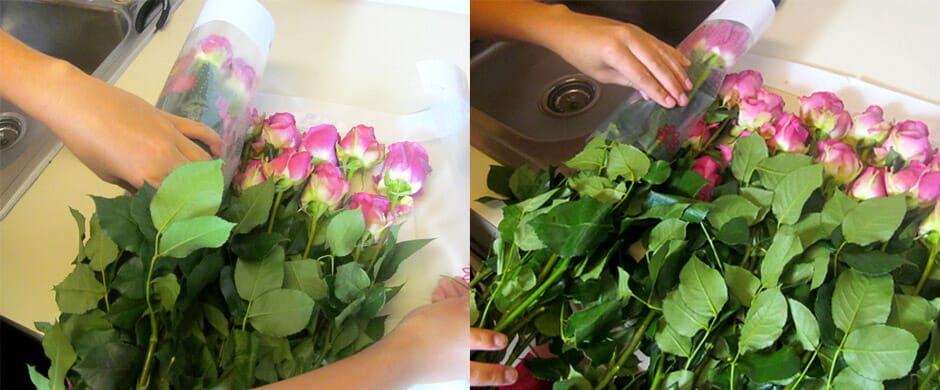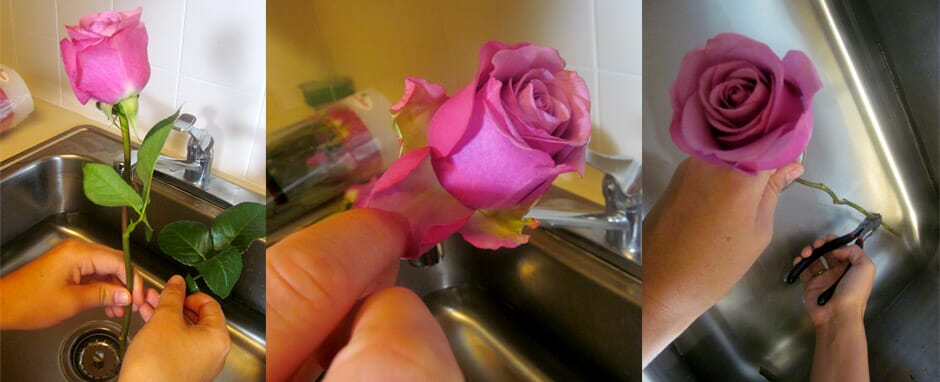CARING FOR FRESH CUT ROSES
Caring for Fresh Cut Roses
Fresh cut roses require some additional care during the preparation process. In addition to cleaning lower leaves and making a clean cut on each stem, roses should be de-thorned and have their guard petals removed before arranging.
Prepare Water Buckets
Gather enough buckets to hold all of your roses “over-stuffing” the containers. Thoroughly clean the buckets with soap and water to remove any contaminants and rinse well. Put lukewarm water in your buckets and mix the recommended amount of floral food or preservative into the water (the food container will have a water to solution/powder ratio). Flower food greatly increases the vase life of the flowers.
TIP: To encourage the roses to open faster, use slightly warmer water (NOT hot!) To slow opening, use cooler water (NOT freezing!)
Unpack Wholesale Roses
Wholesale roses are specially wrapped by growers in packs of 25 to protect the flower heads. While you’ll see only 12 blooms when looking from the top, you’ll see there are still 25 stems below. Carefully remove the plastic wrap if there is one. Then, gently open the cardboard wrap and “unroll” the pack to reveal the two levels of roses.
 Unroll wholesale rose packaging to reveal second layer of flowers.
Unroll wholesale rose packaging to reveal second layer of flowers.
Clean and De-Thorn Roses
Clean out your sink with soap and water to remove any contaminants that could damage your roses. Fill your sink with warm water that is deep enough to allow you to cut the stems under the water. Pick up a rose and start by removing the lower leaves. This will prevent leaves from dying and releasing bacteria in the water which will block the rose’s stem and prevent hydration.
To remove thorns from the rose stem, you can use a thorn stripper or your fingers. If using a thorn stripper, close the stripper below the rose head and gently but firmly pull down the length of the stem. Be very careful not to break the head off, and also watch that the stem around the thorns is not being pulled off. If you find that the stripper is damaging the stem (some rose varieties are more stubborn to de-thorn than others), you may need use your fingers.
To remove thorns manually, gently push each thorn from its side to pop it off the stem. Be careful not to prick your finger! You may find it helpful to put a bandage on your thumb to protect it.
Remove Guard Petals
You may be unhappy to see that the outer petals of your roses may look bruised or damaged. This is intentional! These are called “guard petals”, which growers leave on to protect the inner flower head during packing and transit. To remove the guard petals, gently pinch the base of the petal and pull away from the head. Some varieties have few guard petals, others have more.
Trim Rose Stems
Submerge the bottom of the rose stem in the water and cut the stem at a 45-degree angle under the water’s surface. This will extend the vase life of the flowers as it removes the bottom of the stems that have become blocked with bacteria and air during travel and allows for a flow of nutrients and hydration to reach the flower. Trimming the bottom of the stem under water also prevents new air from getting into the stem by sealing the floral veins. Move the rose directly into your prepared water bucket.
 Remove lower petals, gently pinch off guard petals and cut stem under water.
Remove lower petals, gently pinch off guard petals and cut stem under water.
Hydrate and Open
Place the bucket of cleaned roses in a cool, dark room, away from direct sunlight. Periodically misting the heads will help to keep them hydrated as they drink and open. Generally roses are best left to hydrate overnight, but you may want to let them rest longer to open more.
Preparing Other Kinds of Roses for Arranging
If you are using garden roses, sweetheart roses, or spray roses, you can follow the directions above. Note that garden roses are very, very delicate and need to be handled with care. They have a much shorter vase life than their cousins - about 3-4 days max - and you should plan to arrange and use them in a much shorter timeframe.
